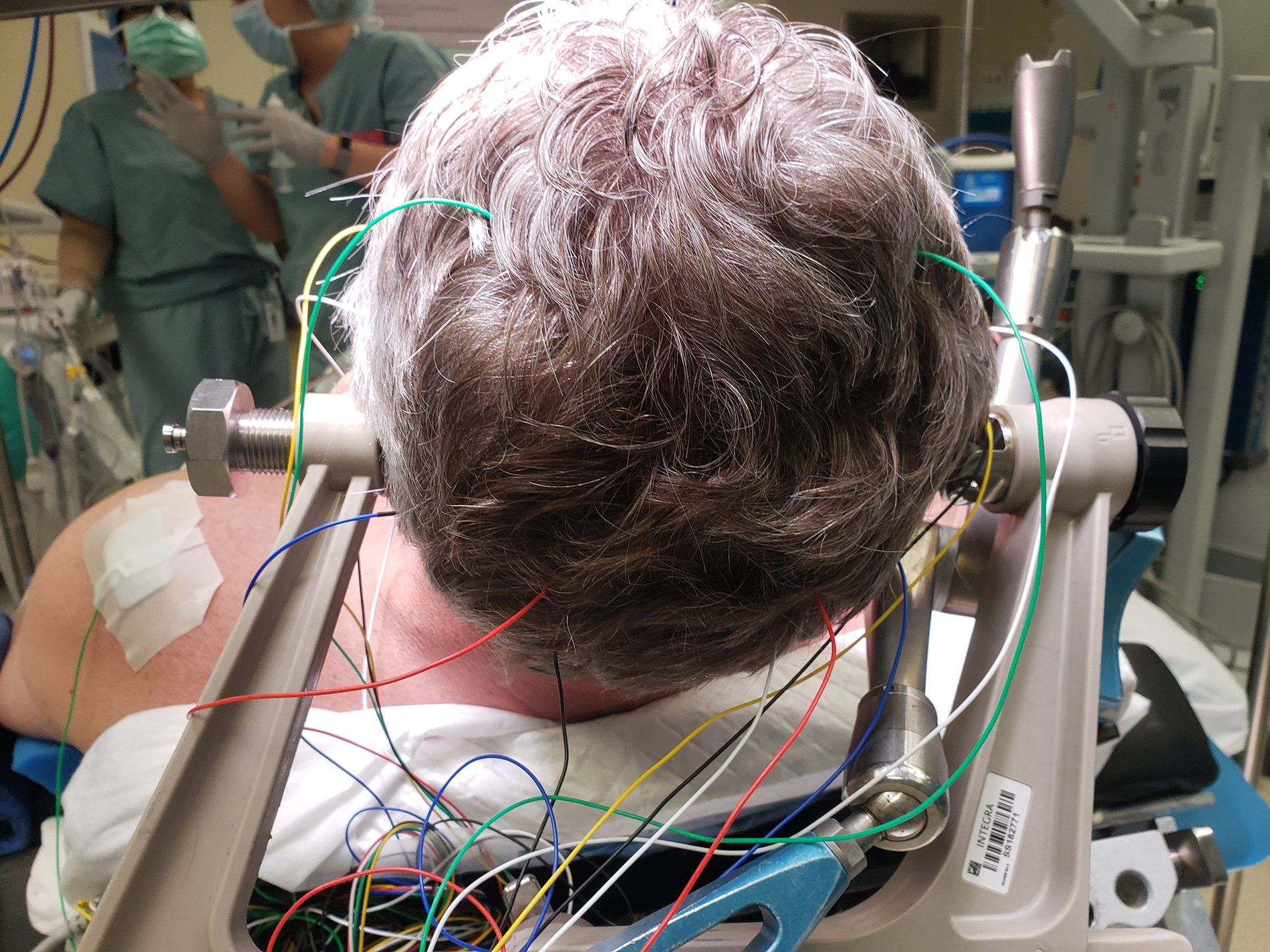YOUR IONM PARTNER
SURGEONS
City skyline
PROCEDURE TYPES WE MONITOR
Below you will find the surgery types that we can monitor intraoperatively.
Orthopedic Surgeries
- Spinal Fusion
- Scoliosis Correction
- Corpectomy
- Discectomy
- Laminectomy
- Spinal Osteotomy
- Acetabular Fractures and Revision
Neurological Surgeries
- Cerebral Aneurysms
- Brain Tumors
- Spinal Cord Tumors
- Microvascular Decompression
- Malformations
Vascular Surgeries
- Carotid Endarterectomy
- Cerebral Aneurysm Clipping/Coiling
- Arteriovenous Malformations
- Abdominal Aortic Aneurysm
Ear, Nose, & Throat Surgeries
- Acoustic Neuroma
- Parotidectomy
- Mastoid Process
- Thyroidectomy
- Cochlear Implant
INTRAOPERATIVE NEUROPHYSIOLOGIC
MONITORING MODALITIES
Below you will find the modalities that we can monitor intraoperatively as well as the structures monitored.
- Brainstem Auditory Evoked Response (BAER)
Brainstem evoked potentials are obtained by stimulating the auditory system with click stimuli. The neural action potentials between the cochlea and the medial geniculate body are evaluated based on the brainstem evoked response. Brainstem evoked responses are sensitive to disturbances of the auditory nerve and to retractor disturbances of the brainstem.
Monitorable Structures
- Cranial Nerve VIII
- Auditory Brainstem Pathways
Surgical Applications
- Acoustic Neuroma Surgery
- Microvascular Decompression of cranial nerves
- Posterior Fossa Surgery
- Skull Base Surgery Requiring Brainstem Retraction
- Vestibular Nerve Section
- Cerebral Venus Oxygen Saturation
Near-infrared absorption measurements are used to calculate an index of cerebral venus oxygen saturation
Monitorable Structures
- Cortical Perfusion
Surgical Applications
- Cardiopulmonary Bypass
- Carotid Endarterectomy
- Cortical Mapping
Language, motor, and sensory areas of the exposed cortex can be identified by direct brain recording or stimulation. The somatosensory response is recorded from the surface of the brain. Language areas are determined by verbal responses during brain stimulation in the awake patient. Motor areas of the cortex and the internal capsule are determined from EMG and evoked by electric brain stimulation.
Monitorable Structures
- Motor Cortex and Internal Capsule
- Language Areas of the Brain
- Sensory Cortex
Surgical Applications
- Brain Tumor Surgery
- Electroencephalogram (EEG)
On going EEG activity from the scalp is recorded from a multi-electrode array and subjected to a fast Fourier transform (FFT) analysis producing a frequency/power spectrum that can be monitored to assess changes in the metabolic state of cortical structures.
Monitorable Structures
- Cortex
Surgical Applications
- Aneurysm (including cerebral aneurysm)
- Carotid Endarterectomy
- Cariopulmonary Bypass
- Evaluation of anesthetic effects
- Electromyography (EMG)
Spinal Nerve Roots: Spontaneous EMG monitoring warns of potential nerve damage during manipulation. Evoked EMG stimulation of the pedicle screws can indicate a misdirected screw placement.
Cranial Nerves: The evaluation of spontaneous and evoked electromyogenic activity can be extremely useful in monitoring cranial nerve function. Spontaneous activity in the distribution of these nerves can signal mechanical disturbance of the cranial nerve.
Peripheral Nerves: The function of peripheral motor nerves can be evaluated during surgery by means of spontaneous and evoked electromyographic activity.
Monitorable Structures
- Spinal Motor Roots
- Cranial Nerves III, IV, V, VI, VII, IX, X, XI, and XII
- All Peripheral Motor Nerves
Surgical Applications
- Cauda Equina Surgery
- Cervical or Lumbosacral Decompression
- Pedicle Screw Instrumentation Surgery
- Acoustic Neuroma
- Anterior Neck Procedures
- Mastoidectomy
- Microvascular Decompression of Cranial Nerves
- Parotid Surgery
- Middle Ear Surgery
- Skull Base Surgery When Motor Cranial Nerves are at Risk
- Thyroidectomy
- Vestibular Nerve Section
- Monitoring of Femoral and Sciatic Nerve Function during Acetabular Surgery
- Peripheral neuroma Surgery
- Somatosensory Evoked Potentials (SSEP)
Somatosensory evoked responses are obtained by stimulating a peripheral nerve at the wrist and/or ankles. The propagation of the sensory action potentials is evaluated along their pathways to the cortex. This modality gives information about the integrity of the sensory pathways. It is also highly correlated with preservation of the spinal cord motor pathways.
Monitorable Structures
- Spinal Cord
- Lumbar and Sacral Nerve Roots
- Monitoring Metabolic Function of Cortical Structures
- Brainstem Somatosensory Pathways
Surgical Applications
- Spinal Deformity Surgery
- Spinal Cord Tumor Surgery
- Cervical and Thoracic Decompression, Fusion, and/or Instrumentation Surgeries
- Aortic Aneurysm
- Lumbosacral Decompression, Fusion Surgeries
- Cauda Equina Surgery
- Sacral-iliac Fracture Reduction
- Carotid Endarterectomy
- Cerebral Aneurysm Surgery
- Skull Base Surgery Requiring Retraction
- Acetabular Fracture
- Transcranial Doppler (TCD)
Blood flow velocity is measured from intracranial arteries using Doppler ultrasound. This technique is used to detect emboli, vasospasm and inadequate blood flow to cortical structures. Microvascular Doppler can also be used to directly assess blood flow within and through an aneurysm.
Monitorable Structures
- Middle Cerebral Artery
- Aneurysm Feeder Arteries
Surgical Applications
- Aneurysm Surgery (Cerebral and Ascending Aortic)
- Carotid Endarterectomy
- Cardiopulmonary Bypass
- Transcranial Evoked Potential (TcMEP)
Motor Evoked Potentials are obtained by transcranial electric stimulation of the cortical motor areas. Monitoring the evoked muscle responses or the descending potentials from the spinal cord (The “D” wave) can assess the integrity of the motor pathways.
Monitorable structures
- Spinal Cord Motor Pathways
Surgical Applications
All Spinal Surgeries that Place the Spinal Cord at Risk Including:
- Spinal Cord Tumor Surgery
- Spinal Deformity Surgery
- Cervical or Thoracic Decompressions,, Fusion and/or Instrumentation Surgeries
- Thoracoabdominal aortic aneurysm
- Visual Evoked Potential (VEP)
Visual evoked potentials are obtained from flash stimulation of the eye, and are measured from the occipital region. They may provide useful information regarding the function of the pre-chiasmal visual pathways, but are labile and require careful anesthetic control. Additionally, retrochiasmal functional changes are difficult to assess using flash visual evoked potentials.
Monitorable Structures
- Optic Nerve Function Anterior to Chiasm
Surgical Applications
- Transsphenoidal Pituitary Tumor Surgery
- Posterior Cerebral Artery Aneurysm

